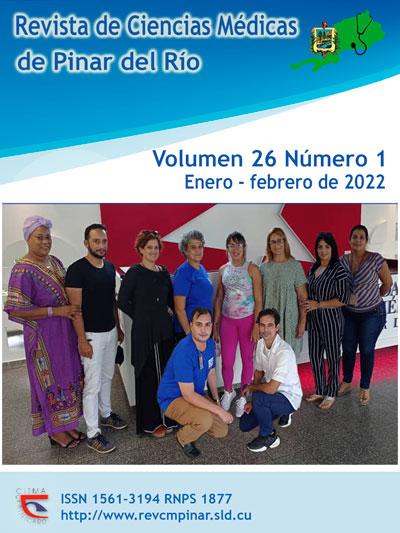La resiliencia en la pareja infértil durante el período de inseminación artificial
Palabras clave:
RESILIENCIA, INFERTILIDAD, REPRODUCCIÓN, INSEMINACIÓN ARTIFICIAL.Resumen
Introducción: la infertilidad constituye un evento que implica una crisis generadora de intenso estrés, tanto individual como de pareja. Por lo que se hace necesario la asunción de conductas que favorezcan la resiliencia ante la nueva condición.
Objetivo: caracterizar el proceso de la resiliencia en la pareja infértil durante el período de inseminación artificial, atendidas en el Centro de Reproducción Asistida del Hospital General Docente “Abel Santamaría Cuadrado” en el periodo noviembre 2020 a febrero 2021.
Métodos: se realizó un estudio descriptivo, de enfoque mixto donde el universo lo constituyó 17 parejas en inseminación artificial. Por criterios de saturación muestral se trabajó con nueve de ellas, atendidas en Consulta de Reproducción entre noviembre de 2020 y febrero de 2021.
Resultados: presentaron niveles altos de resiliencia cuatro parejas, tres parejas en niveles medios y dos mostraron niveles muy heterogéneos. Las dimensiones de la resiliencia más elevadas fueron la autonomía y la autoeficacia. Las mujeres durante este proceso fueron más resilientes que los hombres (56 %), los hombres mostraron pasividad y actitudes derrotistas respecto al proceso (33 %).
Conclusiones: las parejas con elevados niveles de resiliencia favorecieron el proceso de inseminación artificial desde el bienestar psicológico que alcanzaron, inhibiendo los estados emocionales negativos que atentaron contra el éxito del proceso. La autoeficacia y la autonomía condujeron a las parejas a manifestar confianza y seguridad en sí mismos y en el éxito del proceso.
Descargas
Citas
1. MedlinePlus. Infertilidad [Internet]. MedlinePlus; 2020 [Citado 12/03/2021]. Disponible en: https://medlineplus.gov/spanish/ency/article/001191.htm
2. Montejano Villaseñor RA. Embarazo y maternidad infantil en México Derechos humanos en riesgo. Política y Cultura [Internet]. 2020 Ene-Jun [Citado 11/08/2021]; (53): 87-104 Disponible en: https://polcul.xoc.uam.mx/index.php/polcul/article/view/1422
3. Barco Díaz V, Quintero Caballero C, Reyes Pérez A, Álvarez Figueredo ZC. El modelo de la adaptación ante la infertilidad de la pareja. Rev Cubana Enfermer [Internet]. 2014 [Citado 11/08/2021]; 30(4). Disponible en: http://www.revenfermeria.sld.cu/index.php/enf/article/view/261/103
4. Programa Nacional de Atención a la Pareja Infértil. Reglamento, Guías y otros documentos aprobados para el funcionamiento de la Red en la Atención a la Pareja Infértil en el Sistema Nacional de Salud. La Habana: Minsap; 2012.
5. Domínguez Cruz AM. Banco de semen en Cuba: un camino para tratar la infertilidad masculina. Juventud Rebelde [Internet]. 2018 [Citado 11/08/2021]; Disponible en: http://www.juventudrebelde.cu/cuba/2018-11-03/cuando-los-suenos-necesitan-ayuda
6. Gámez D, Batista AD, Vaillant M, Dueñas O,Varona P. Caracterización clínico-epidemiológica de parejas infértiles. Rev Cubana Med Gen Integr [Internet]. 2019 [Citado 11/08/2021]; 34(4). Disponible en: http://www.revmgi.sld.cu/index.php/mgi/article/view/999
7. Fernández Ferrera B. Repercusión de los valores de resiliencia en las parejas estériles en los resultados de tratamientos de fecundación invitro. [Tesis]. España: Universidad de Oviedo; 2018 [Citado 11/08/2021]; Disponible en: http://hdl.handle.net/10651/46384
8. Borrás A, Guimerà M, Barrral Y, Agustí I, Manau Trullás MD. Pandemia del SARS-CoV-2 y reproducción asistida. Clin Invest Ginecol Obstet [Citado 11/08/2021]; 47(3): 96–105. Disponible en: https://www.ncbi.nlm.nih.gov/pmc/articles/PMC7303616/
9. González Cruz C, Morffi Collado CL. Las Técnicas de Reproducción Humana Asistida. Propuesta de lege ferenda en el ordenamiento jurídico cubano. Revista Academia y Derecho [Internet]. 2020 [Citado 11/08/2021]; 19(10). Disponible en: http://www.unilibrecucuta.edu.co/ojs/index.php/derecho/article/view/362
10. Díaz Bernal Z. Representaciones socioculturales de la infertilidad y de su atención en los servicios de salud [Tesis]. La Habana: Escuela Nacional de Salud Pública; 2013 [Citado 11/08/2021]. Disponible en: http://tesis.sld.cu/index.php?P=DownloadFile&Id=186
11. Romero Pareja A. El principio de veracidad biológica y la elección del sexo de los hijos según la Ley española de reproducción humana asistida. Sanid Mil [Internet]. 2020 Ene-Mar [Citado 11/08/2021]; 76(1): 30-5. Disponible en: http://scielo.isciii.es/scielo.php?script=sci_arttext&pid=S1887-85712020000100006
12. Borda Rivera EA, Medina Gordillo SY, Turpo Gebera O. Violencia en las relaciones sociales y capacidad de resiliencia en una comunidad educativa. Revista Universidad y Sociedad [Internet]. 2019 [Citado 11/08/2021]; 11(2): 78-89. Disponible en: http://scieloprueba.sld.cu/scielo.php?script=sci_arttext&pid=S221836202019000200078&lng=es&tlng=es
13. Instituto Chileno de Salud Reproductiva. Salud sexual y reproductiva [Internet]. Santiago de Chile. ICMER; 2019 [Citado 11/08/2021]. Disponible en: https://icmer.org/index.php/acerca-de-icmer/principios-orientadores-de-icmer
14. Roca MA. Psicología Clínica. Una mirada desde la salud humana. La Habana: Editorial Félix Varela; 2013. p. 8-13.
Publicado
Cómo citar
Número
Sección
Licencia
Aquellos autores/as que tengan publicaciones con esta revista, aceptan los términos siguientes:- Los autores/as conservarán sus derechos de autor y garantizarán a la revista el derecho de primera publicación de su obra, el cuál estará simultáneamente sujeto a la Licencia de reconocimiento de Creative Commons que permite a terceros compartir la obra siempre que se indique su autor y su primera publicación esta revista.
- Los autores/as podrán adoptar otros acuerdos de licencia no exclusiva de distribución de la versión de la obra publicada (p. ej.: depositarla en un archivo telemático institucional o publicarla en un volumen monográfico) siempre que se indique la publicación inicial en esta revista.
- Se permite y recomienda a los autores/as difundir su obra a través de Internet (p. ej.: en archivos telemáticos institucionales o en su página web) antes y durante el proceso de envío, lo cual puede producir intercambios interesantes y aumentar las citas de la obra publicada. (Véase El efecto del acceso abierto).



